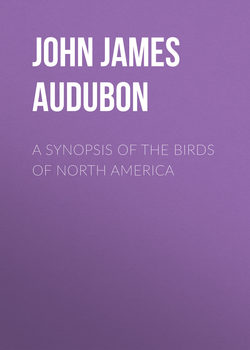Читать книгу A Synopsis of the Birds of North America - John James Audubon - Страница 22
FAMILY VI CAPRIMULGINÆ. GOATSUCKERS
ОглавлениеMouth opening to beneath the centre of the eyes; bill much depressed, generally feeble, the horny part being small; upper mandible with the tip somewhat decurved. Nostrils elliptical, prominent, marginate. Eyes extremely large. Aperture of ear elliptical, very large. Head of extreme breadth, depressed; body very slender. Feet very small; tarsus partially feathered, scaly; anterior toes webbed at the base; hind toe small, and versatile, all scutellate above; claw of third toe generally elongated, with the inner margin thin and pectinate. Plumage very soft and blended. Wings very long, the second and third quills longest. Tail long, of ten feathers. Œsophagus rather wide, without crop; stomach very large, roundish, its muscular coat very thin, and composed of a single series of strong fasciculi; epithelium very hard, with longitudinal rugæ; intestine short and wide; cœca large, oblong, narrow at the base; cloaca globular. Trachea of nearly uniform width, without inferior laryngeal muscles. Nest on the ground, or in hollow trees. Eggs generally two. Young covered with down. Very nearly allied in some respects to the Owls.
GENUS I. CAPRIMULGUS, Linn. GOATSUCKER
Bill feeble, gape extending to beneath the posterior angle of the eye. Nostrils elliptical, prominent. Wings long, pointed, the second quill longest; tail long. Claw of middle toe pectinate. Along the base of the bill on each side, a series of feathers having very strong shafts, terminating in an elastic filamentous point, and with the barbs or lateral filaments extremely slender, distant, and not extended beyond the middle of the shaft. Plumage very soft and blended. Wings long and pointed, the second quill longest; tail long, rounded.
41. 1. Caprimulgus Carolinensis, Gmel. Carolina Goatsucker. – Chuck-will's-widow
Plate LII. Male and Female.
Bristles with lateral filaments; tail slightly rounded. Head and back dark brown, minutely mottled with yellowish-red, and longitudinally streaked with black; three bands of the latter colour, from the lower mandible diverging along the head; a yellowish-white line over the eye; wings barred with yellowish-red and brownish-black, and minutely sprinkled with the latter colour, as are the wing-coverts, which, together with the scapulars, are largely spotted with black, and tinged with grey; tail similarly barred and dotted; terminal half of the inner webs of the three outer feathers white, their extremities light red; lower parts dull reddish-yellow, sprinkled with dusky; a band of whitish feathers barred with black on the fore neck. Female like the male, but without white on the tail.
Male, 123/4, 26. Female, 131/4, 30.
From Texas to North Carolina. Up the Mississippi to Natchez. Resident in the Floridas.
Chuck-will's-widow, Caprimulgus Carolinensis, Wils. Amer. Orn. v. vi. p. 95.
Caprimulgus Carolinensis, Bonap. Syn. p. 61.
Chuck-will's-widow, Caprimulgus Carolinensis, v. i. p. 612.
Chuck-will's-widow, Caprimulgus Carolinensis, Aud. Orn. Biog. v. i. p. 273; v. v. p. 401.
42. 2. Caprimulgus vociferus, Wils. Whip-poor-will Goatsucker
Bristles without lateral filaments; tail much rounded. General colour of upper parts dark brownish-grey, streaked and minutely sprinkled with brownish-black; quills and coverts dark brown, spotted in bars with light brownish-red; four middle tail-feathers like those of the back, the three lateral white in their terminal half; throat and breast similar to the back, with a transverse band of white on the fore neck, the rest of the lower parts paler and mottled. Female like the male, but with the lateral tail-feathers reddish-white toward the tip only, and the band across the fore neck pale yellowish-brown.
Male, 91/2, 19. Female.
From Texas to Lake Huron, and the base of the Rocky Mountains. A few remain in winter in Florida.
Whip-poor-will, Caprimulgus vociferus, Wils. Amer. Orn. v. v. p. 71.
Caprimulgus vociferus, Bonap. Syn. p. 62.
Whip-poor-will, Caprimulgus vociferus, Aud. Orn. Biog. v. i. p. 422; v. v. p. 405.
Whip-poor-will, Caprimulgus vociferus, Nutt. Man. v. i. p. 614.
GENUS II. CHORDEILES, Swainson. NIGHT-HAWK
Mouth opening to beneath the centre of the eyes; bill extremely small; upper mandible with the tip decurved, and a deep lateral groove. Nostrils oblong, prominent, marginate. Eyes very large. Aperture of ear elliptical, very large. Head very large, depressed, but less so than in Caprimulgus. Claw of middle toe pectinate. No bristles at the base of the upper mandible. Wings very long, pointed, with the first quill longest, and the secondaries very short. Tail emarginate.
43. 1. Chordeiles Virginianus, Briss. Virginian Night-Hawk. – Bat. Crapaud volant
Plate CXLVII. Male and Female.
Upper parts brownish-black, mottled with white and pale reddish-brown; a conspicuous white bar extending across the inner web of the first, and the whole breadth of the next four quills; tail-feathers barred with brownish-grey, the four outer on each side plain brownish-black towards the end, with a large white spot; sides of the head and fore neck mottled like the back; a broad white band, in the form of the letter V reversed on the throat and sides of the neck; the rest of the lower parts greyish-white, transversely undulated with dark brown. Female similar, with the dark parts more brown, the white more tinged with red, the band on the throat brownish-white, and the white spots on the tail-feathers wanting.
Male, 91/2, 231/2. Female, 93/4, 233/4.
From Texas northward. Columbia River. Throughout the interior. Migratory. Very abundant.
Night-Hawk, Caprimulgus Americanus, Wils. Amer. Ornith. Biog. v. v. p. 65.
Caprimulgus Virginianus, Bonap. Syn. p. 62.
Caprimulgus (Chordeiles) Virginianus, Swains. & Rich. F. Bor. Amer. v. i. p. 62.
Night-Hawk, Caprimulgus Americanus, Nutt. Man. v. i. p. 619.
Night-Hawk, Caprimulgus Virginianus, Aud. Orn. Biog. v. ii. p. 273; v. v. p. 406.
